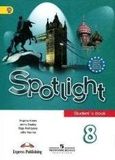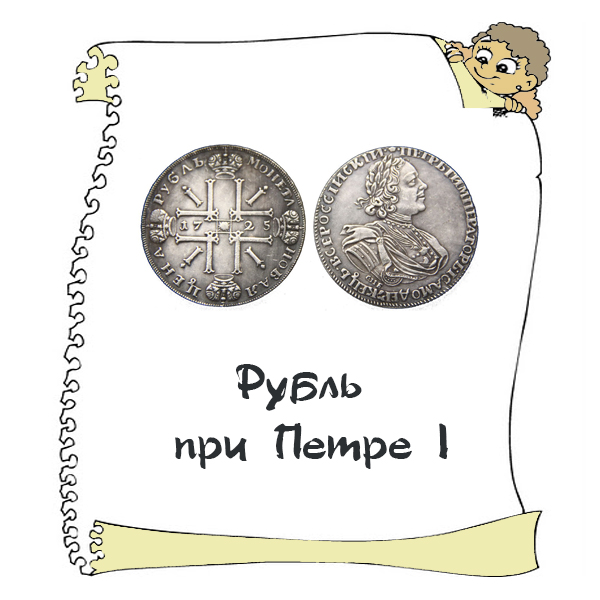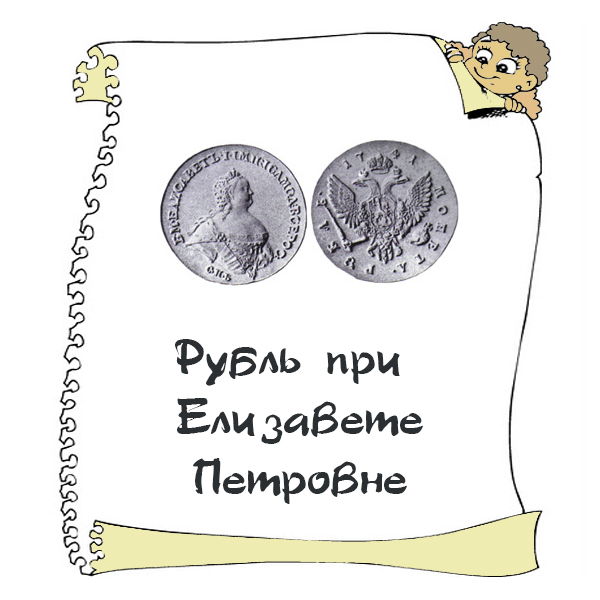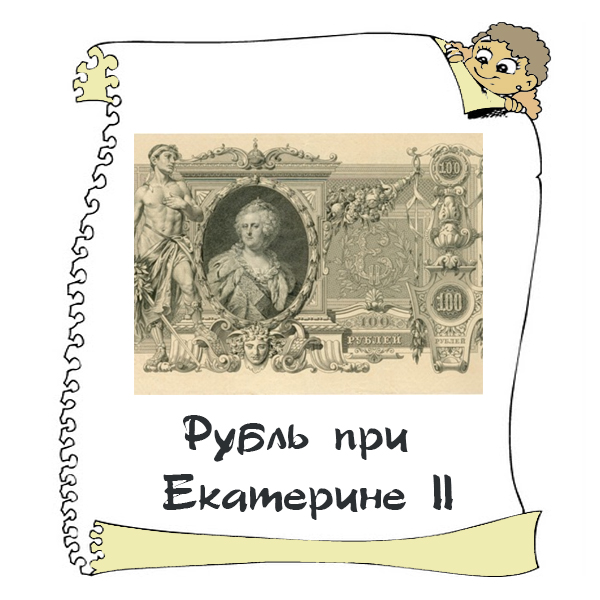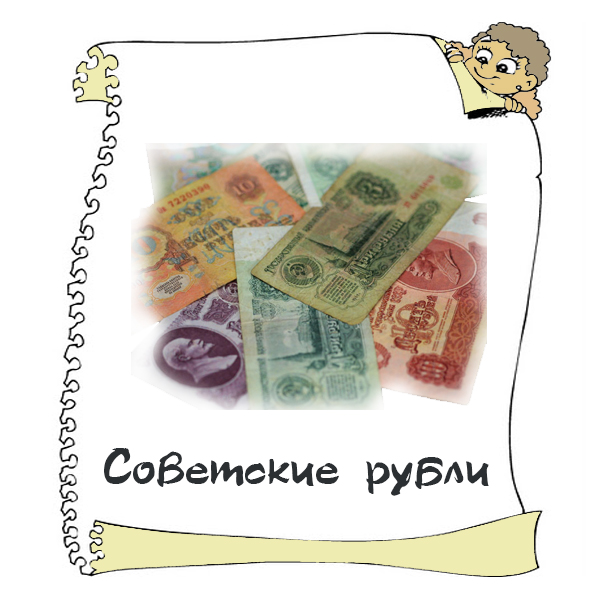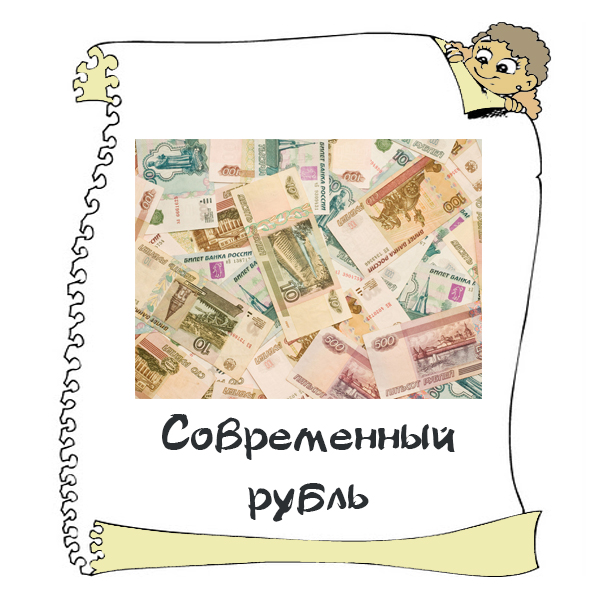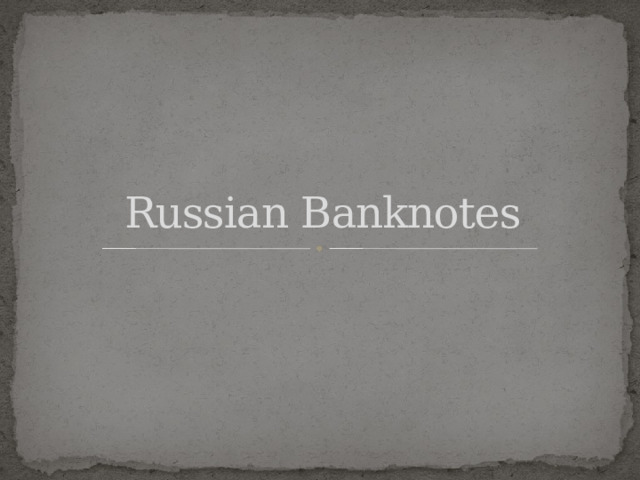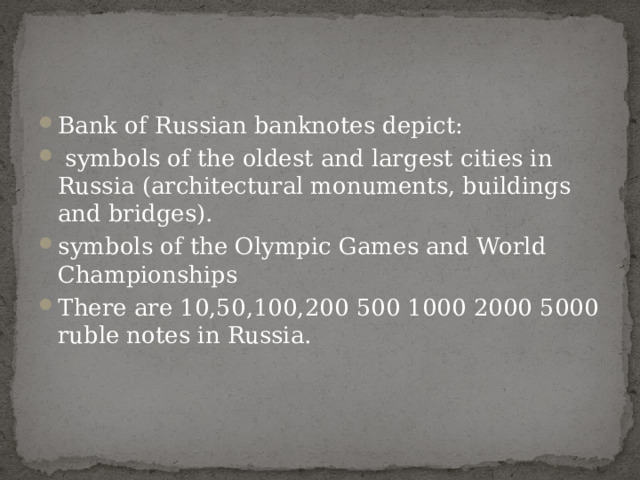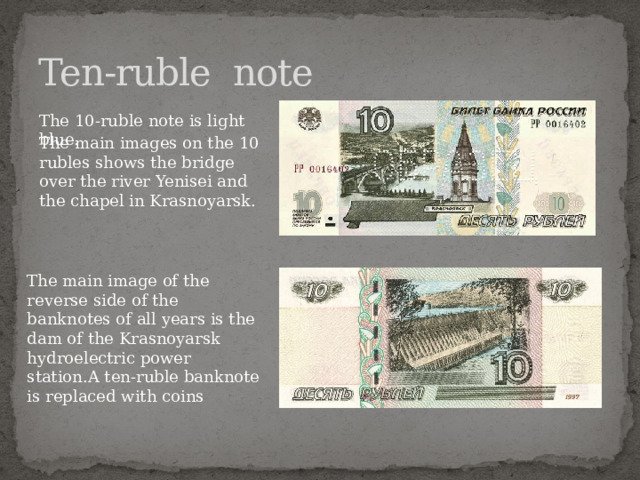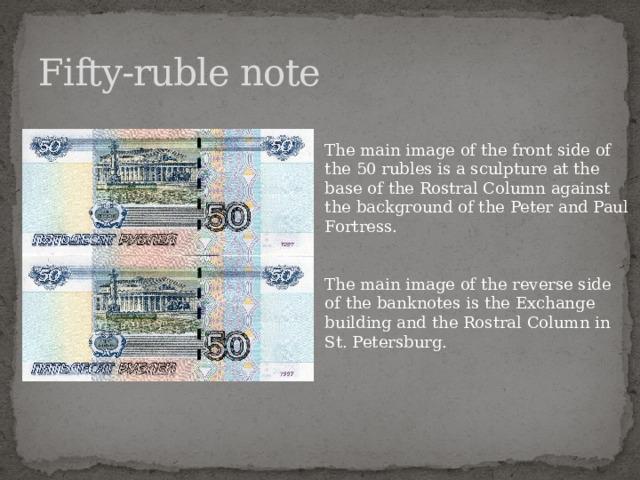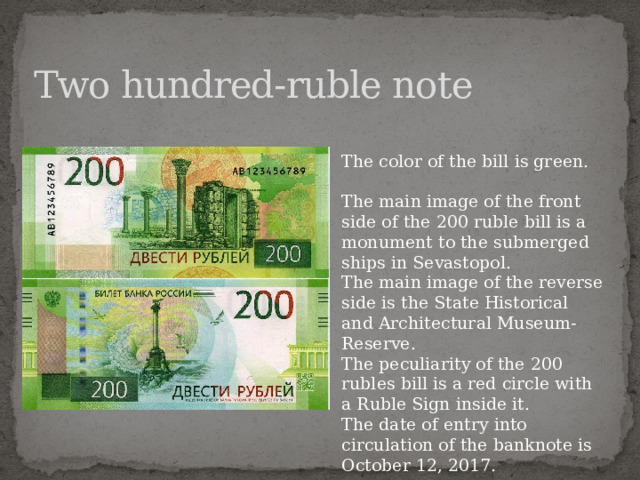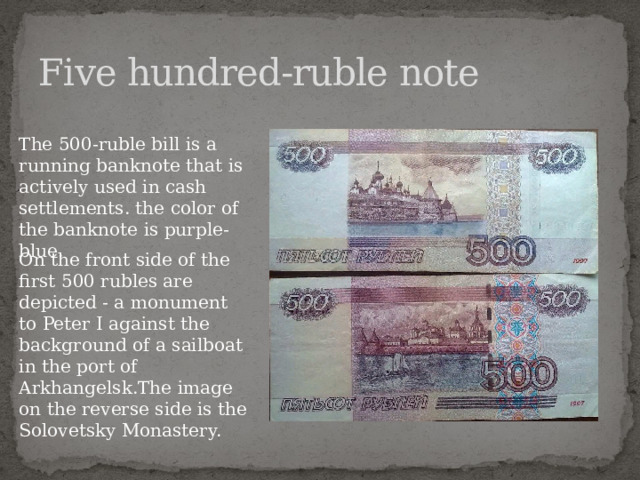The first Russian coins were minted when Russia was converted to Christianity. The gold and silver coins of Kievan Rus were first made in the late 10th – early 11th century and were called “zlatnik” and “srebrenik”.
The currency of Russia is called “rouble” . It has been used in our country since the 13th century. Rouble’s name originates from a word “rubit” which means “to chop”, because the first silver coins were cleaved with axes.
In the early 16th century the main currency unit was the silver kopeck with an image of Saint George with a lance (“kopye” in Russian) which was Russia`s emblem and the symbol of grand-ducal power.
In the 17th century Peter the Great brought into circulation silver coins of various denominations: one-rouble, fifty-kopeck, ten-kopeck and other coins. The history of Russian paper money goes back as far as the reign of Catherine II. Paper banknotes of 25, 50, 75 and 100 rouble denomination were first produced at Krasnoselsk factory, and later in Tsarskoye Selo.
In the post-revolution period the first paper banknotes of Soviet Russia were issued. Soviet rubles mostly had Lenin’s bust on the front side and image of Kremlin on the back side. As for modern Russian banknotes, all of them have an illustration of famous monuments and viewpoints from different cities of Russia: Rostral Column in Saint Petersburg, monument to Peter the Great in Arkhangelsk, Novgorod Kremlin, Bolshoi Theater in Moscow, monument to Yaroslav the Wise in Yaroslavl and many others.
Перевод
Первые русские монеты начали чеканить, когда Россия была обращена в христианство. Золотые и серебряные монеты Киевской Руси впервые стали изготавливать в конце Х — начале XI веков и назывались «златниками» и «сребрениками».
Национальная валюта России называется «рубль». Он используется в нашей стране с XIII века. Название «рубль» происходит от слова «рубить», означающее «шинковать», поскольку первые серебряные монеты раскалывали топорами.
В начале XVI века основной единицей валюты была серебряная копейка с изображением Святого Георгия с копьем, олицетворяющим эмблему России и символ великокняжеской власти.
В XVII веке Петр Великий ввел в обращение серебряные монеты различного достоинства: один рубль, 50 копеек, 10 копеек и другие. История русских бумажных денег уходит к эпохе правления Екатерины II. Первоначально бумажные банкноты достоинством 25, 50, 75 и 100 рублей печатали на Красносельской фабрике, а затем в Царском Селе.
В послереволюционный период были выпущены первые бумажные банкноты Советской России. Лицевая сторона советских рублей изображала, в основном, бюст Ленина, а оборотная сторона – вид Кремля. Что касается современных российских банкнот, все они содержат иллюстрации известных памятников и достопримечательностей разных городов России: Ростральной колонны в Санкт-Петербурге, памятника Петру Великому в Архангельске, Новгородского Кремля, Большого Театра в Москве, памятника Ярославу Мудрому в Ярославле и многих других.
История русских монет и банкнот (History of Russian banknotes and coins.) — 4.7 out of
5
based on
18 votes
10 rubles. On the front side of the banknote is a view of the bridge over the Yenisei and the chapel in Krasnoyarsk (a monument of the XIX century); on the back — a view of the dam of the Krasnoyarsk Hydroelectric Power Station.
10 рублей. На лицевой стороне банкноты вид на мост через Енисей и часовню в Красноярске (памятник XIX века); на оборотной стороне — вид на плотину Красноярской ГЭС.
50 rubles. On the obverse of the banknote is a sculpture at the base of the Rostral Column, on the back is a general view of the Stock Exchange building and the Rostral Column on the Neva Embankment (St. Petersburg).
50 рублей. На лицевой стороне банкноты находится скульптура у основания Ростральной колонны, на оборотной стороне — общий вид здания Биржи и Ростральной колонны на Невской набережной (Санкт-Петербург).
100 rubles. On the obverse of the banknote is a quadriga on the portico of the building of the State Academic Bolshoi Theater (Moscow), and on the back is a general view of the building of the Bolshoi Theater.
100 рублей. На лицевой стороне банкноты находится квадрига на портике здания Государственного академического Большого театра (Москва), а на оборотной стороне — общий вид здания Большого театра.
500 rubles. On the obverse of the banknote is a sculpture of Peter I with a view of the port of Arkhangelsk, on the back is a general view of the monastery on the Solovki islands.
500 рублей. На лицевой стороне банкноты находится скульптура Петра I с видом на порт Архангельск, на оборотной стороне — общий вид монастыря на Соловецких островах.
1000 rubles. On the obverse of the banknote is a sculpture of Prince Yaroslav the Wise (city of Yaroslavl), on the back is a general view of the Church of St. John the Baptist and the bell tower in Yaroslavl.
1000 рублей. На лицевой стороне банкноты изображена скульптура князя Ярослава Мудрого (город Ярославль), на оборотной стороне — общий вид церкви Иоанна Крестителя и колокольни в Ярославле.
5000 rubles.
The obverse depicts a monument to Nikolai Nikolayevich Muravyov-Amursky, who was a prominent statesman in Russia. The author of this work is Alexander Mikhailovich Opekushin.
On the reverse side is a bridge across the Amur in Khabarovsk. It is noteworthy that the design of the banknote was developed in 1997. The predominant color of the bill is orange-red.
5000 рублей.
На аверсе изображен памятник Николаю Николаевичу Муравьеву-Амурскому, который был выдающимся государственным деятелем в России. Автором этой работы является Александр Михайлович Опекушин.
На оборотной стороне находится мост через Амур в Хабаровске. Стоит отметить, что дизайн банкноты был разработан в 1997 году. Преобладающий цвет счета оранжево-красный.
Обновлено: 11.03.2023
I know only Queen Elizabeth II the ruling queen of the United Kingdom, and have heard a little about Adam Smith, who was a famous economist. I think these people are shown on the English banknotes. — Я знаю только королеву Елизавету II, правящую королеву Соединенного Королевства, и немного слышал об Адаме Смите, который был известным экономистом. Я думаю, эти люди изображены на английских банкнотах.
2A. Read the text again. Makee derivatives of the words on the right so that they fit the text. Complete the blanks with those new words. — Прочитайте текст еще раз. Образуйте производные из слов справа и заполните пробелы этими новыми словами.
2B. Listen and read the text again. What is each person famous for? — Послушайте текст и прочитайте его еще раз. Чем каждая из этих персон знаменита?
We can see Queen of the United Kingdom Elizabeth II on the front side of all English banknotes. On the back side of fivers, we can see Elizabeth Fry, famous for her social activities in improving living conditions for women in European prisons. We could see the portrait of British composer Edward Elgar on the back side of twenty-pound notes recently. Also until 2020, we could see a portrait of economist Adam Smith on the back side of twenty-pound notes. In 2020 the Bank of England emitted new version of twenty-pound note with a portrait of famous English Romantic painter William Turner.
Мы можем увидеть королеву Соединенного Королевства Елизавету II на лицевой стороне всех английских банкнот. На оборотной стороне пятерки мы видим Элизабет Фрай, известную своей общественной деятельностью по улучшению условий жизни женщин в европейских тюрьмах. До недавнего времени мы могли увидеть портрет британского композитора Эдварда Элгара на обратной стороне двадцатифунтовой купюры. Также до 2020 года на обратной стороне двадцатифунтовой купюры мы могли увидеть портрет экономиста Адама Смита. В 2020 году Банк Англии выпустил новую версию двадцатифунтовой купюры с портретом знаменитого английского романтического художника Уилльяма Тёрнера.
3. Match the words in bold to their meanings. — Сопоставьте слова, выделенные в тексте жирным шрифтом с их значениями.
- small parts that are difficult to see — details — небольшие части, которые трудно увидеть — детали
- meaning the same as — representing — означает то же самое — представляющий, отображающий
- a person who makes something new or better — reformer — персона, которая делает что-то новое или лучшее — реформатор
- an annoying person or thing — nuisance — раздражающий человек или предмет — неудобный, неприятный, надоедливый
4. Complete with: name, call, make. Explain the phrases. Are there similar ones in your language? — Вставьте слова name, call, make. Объясните фразы. Есть ли похожие в вашем языке?
- She was crying because some rude boys called her names. — Она плакала, потому что некоторые грубые мальчишки обзывали ее.
- He made a name for himself as a painter. — Он сделал себе имя как художник.
- Have you chosen a name for the baby? — Вы уже выбрали имя для ребенка?
- to call names — to say something unpleasant and insulting about someone — обзываться — говорить что-то неприятное и оскорбительное о ком-нибудь;
- to make a name — to became famous — сделать имя — стать знаменитым;
- name — usually we identify someone by name — имя — обычно мы идентифицируем кого-нибудь по имени.
5. Collect information on the history and development of banknotes/coins in your country. Present it to the class. — Соберите информацию по истории и развитию банкнот/монет в вашей стране. Представьте ее классу.
The first paper banknotes in Russia appeared in 1769 during the ruling of Catherine the Second. They were to replace copper coins when making large payments. The first banknotes were quite simple and reminded moneylenders’ receipts. So, people learned how to forge them very quickly. Because of the large number of counterfeit banknotes, people preferred to continue using copper and silver coins.
With the development of printing equipment, banknotes became more difficult to forge. There were small and complex patterns, metallographic printing, half-tones and watermarks. In the 19th century, banknotes with a face value of 500, 100, 50, 25, 10, 5, 3 and 1 rubles were printed according to this complicated technology. They typically depicted the State coat of arms of the Russian Empire, as well as portraits of Russian rulers. In the 20th century, the banknotes of our country stopped depicting the famous rulers of the state, they were replaced by the portrait of Lenin. On the back side of the banknotes, you could see the picture of the Moscow Kremlin.
Modern Russian banknotes are unbelievably beautiful and colourful. We can see images of various memorable places in our country on them:
Первые бумажные деньги в России появились в 1769 году во время царствования Екатерины Второй. Они должны были заменить медные монеты при осуществлении крупных платежей. Первые бумажные деньги были очень простыми и напоминали расписки ростовщиков. Поэтому их очень скоро научились подделывать. Из-за большого количества фальшивых банкнот люди предпочитали по-прежнему пользоваться медными и серебряными монетами.
С развитием печатного оборудования банкноты стали более сложными для подделки. Появились мелкие и сложные узоры, объемная печать, полутона и водяные знаки. В XIX веке по этой технологии печатаются купюры достоинством 500, 100, 50, 25, 10, 5, 3 и 1 рублей. На них обычно изображались государственный герб Российской империи, а также портреты русских правителей. В XX веке на купюрах нашей страны перестали изображать знаменитых правителей государства, их заменил портрет Ленина. На обратной стороне купюры изображались виды Московского Кремля.
Современные российские деньги невероятно красивые и красочные. На них мы можем увидеть изображения различных памятных мест нашей страны:
The 10-Ruble banknote is dark-green and dark-brown in color. On the one side there is an engraving showing a bridge across the River Yenisei in Krasnoyarsk and a chapel on a multicolored background. On the other side there is the logo of the Bank of Russia.
10ти рублевая банкнота темно зеленого и темно коричневого цвета. На одной стороне гравировка изображающая мост через реку Енисей в Красноярске и часовня на цветном фоне. На другой стороне изображен логотип банка России.
*Цитирирование части задания со ссылкой на учебник производится исключительно в учебных целях для лучшего понимания разбора решения задания.
Популярные решебники 8 класс Все решебники
Главная задача сайта: помогать школьникам и родителям в решении домашнего задания. Кроме того, весь материал совершенствуется, добавляются новые сборники решений.
The Russian ruble is the monetary unit of the Russian Federation. The ruble is the oldest national currency in the world after the British pound. Monetary units of other states have repeatedly changed their names. In Russia, the ruble has been used since the 13th century. On January 1, 1998, coins in denominations of 1 kopeck to 5 rubles were put into circulation, commemorative coins began to be minted in 1999, and since 2009, circulation coins in denominations of 10 rubles. In 2011, commemorative coins in denominations of 25 rubles with the emblem of Russia on the obverse appeared in circulation. In order to protect the economy from the flow of money from countries of the former Soviet Union that have already introduced their own currencies and to keep inflation from July 26 to August 7, 1993 in Russia a monetary reform was carried out, during which banknotes of all previous issues were withdrawn from circulation, and tickets of the Bank of Russia of the 1993 type were recognized as the only legal means of payment. In 2013, a series of commemorative banknotes of 100 rubles was born. 100 rubles were devoted to the 2018 World Cup.
Перевод:
Российский рубль — денежная единица Российской Федерации. Рубль — старейшая в мире национальная валюта после британского фунта. Денежные единицы других государств неоднократно меняли названия. На территории России рубль используется с XIII века. 1 января 1998 года в обращение были введены монеты номиналом от 1 копейки до 5 рублей, с 1999 года начали чеканиться памятные монеты, а с 2009 года — циркуляционные монеты номиналом 10 рублей. В 2011 году в обращении появились памятные монеты номиналом 25 рублей с гербом России на аверсе.С целью защиты экономики от потока денежной массы из стран постсоветского пространства, которые уже ввели собственные валюты, и удержания инфляции, с 26 июля по 7 августа 1993 года в России была проведена денежная реформа, в ходе которой из обращения были выведены банкноты всех предыдущих выпусков, а единственным законным средством платежа признавались билеты Банка России образца 1993 года. В 2013 году зародилась серия памятных банкнот в 100 рублей. 100 рублей были посвящены чемпионату мира по футболу 2018 года.
Практически все важные события России приводили к изменению денег: происходила замена монет, менялись портреты правителей, изображенных на банкнотах, а также символика государства.
Гарантированный ответ в течение часа
История возникновения и развития рубля
В 15 веке изготавливали серебряный рубль в Новгороде, ставший главной денежной единицей. Во времена Дмитрия Донского Московское княжество изготавливало свои монеты. Слиток вытягивали, разделяли на равные части и придавали им необходимую форму. В начале 16 века осуществили денежную реформу, после этого стали чеканить единую монету для государства. На ней изображался всадник, держащий копье, поэтому ее стали называть копейкой. Рубль составлял сто копеек, оставался только счетной единицей, не чеканился.
При династии Романовых начали чеканить золотые, называемые червонцами, появился серебряный рубль в середине 17 века. Его изготавливали, как и европейский талер, но технически проще было ввозить монеты из Европы, а надчеканкой получать отечественные деньги. Настоящий рубль появился при Петре I, а разменные монеты стали медными.
Как появились первые бумажные рубли?
Нынешние банкноты люди считают более важными денежными знаками, чем монеты. Но всего три столетия назад в нашем государстве единственными денежными знаками выступали именно монеты. При Елизавете Петровне возникла идея о бумажных ассигнациях. Сенат не воспринял данный вопрос серьезно, так как считалось, что бумага не сможет заменить настоящие деньги.
Рубли неоднократно видоизменялись:
- К концу 18 века происходит падение курса из-за больших затрат для ведения военной кампании. В начале 19 века начали печатать ассигнации нового вида с помощью появившихся тогда паровых бумагоделательных машин.
- В 1843 году начинается выпуск кредитных билетов, а старые деньги выкупались у населения по низкому курсу. Эти денежные знаки отличались более высоким качеством, чем предыдущие.
- При производстве денег в 60-х годах 19 века применили металлографическую печать. На них поместили портреты выдающихся исторических лиц.
- Проведенная Витте денежная реформа обеспечила обмен банкнот на золото.
Рубль в советское время
После крушения монархии у власти оказались большевики, ситуация осложнялась отсутствием плана или финансовой программы для преодоления кризиса. Они предпринимали неоднократные попытки для восстановления финансовой системы. В конце 20-х годов произошел рывок в экономике, создавались различные отрасли промышленности, шло бурное развитие государства.
История советского рубля состоит из таких периодов:
- В 20-х годах XXвека выпускается первый золотой червонец.
- Спустя одно десятилетие основную часть денег составляли бумажные рубли, монеты.
- В 60-х провели денежную реформу, ее целью был выпуск надежных, хорошо защищенных денег. Также изготавливаются юбилейные монеты, для производства которых берутся драгоценные металлы. Остальные монеты делают из сплавов, обеспечивающих высокую прочность, износостойкость денег.
- Последние монеты образца 60-х выпускались в 1991 году, тогда же осуществили выпуск монет совершенно нового образца.
Современный рубль и его будущее
Эмиссия денег проводилась в 1992 году, произошло обесценивание накоплений, снижение зарплат, пенсий. В 1998 году наметился экономический рост, была осуществлена деноминация (изменение стоимости и обмен денег).
Современные рубли признаны одной из наиболее защищенных валют, имеют такие виды защиты:
Читайте также:
- Сообщение животные обитатели суши 3 класс
- Составить авторское сообщение о любом известном враче 20 25 предложений
- Сообщение на тему морские ежи
- Полное сообщение о положении дел в империи российской
- Сообщение о бабочке морфо
Russian Banknotes
- Bank of Russian banknotes depict:
- symbols of the oldest and largest cities in Russia (architectural monuments, buildings and bridges).
- symbols of the Olympic Games and World Championships
- There are 10,50,100,200 500 1000 2000 5000 ruble notes in Russia.
Ten-ruble note
The 10-ruble note is light blue.
The main images on the 10 rubles shows the bridge over the river Yenisei and the chapel in Krasnoyarsk.
The main image of the reverse side of the banknotes of all years is the dam of the Krasnoyarsk hydroelectric power station.A ten-ruble banknote is replaced with coins
Fifty-ruble note
The main image of the front side of the 50 rubles is a sculpture at the base of the Rostral Column against the background of the Peter and Paul Fortress.
The main image of the reverse side of the banknotes is the Exchange building and the Rostral Column in St. Petersburg.
Hundred-ruble note
The main image of the front side is a quadriga of horses on the portico of the Big Theater building. The main image of the reverse side is the building of the Big Theater in Moscow
The format, color and design of 100 rubles did not change.
Two hundred-ruble note
The color of the bill is green.
The main image of the front side of the 200 ruble bill is a monument to the submerged ships in Sevastopol.
The main image of the reverse side is the State Historical and Architectural Museum-Reserve.
The peculiarity of the 200 rubles bill is a red circle with a Ruble Sign inside it.
The date of entry into circulation of the banknote is October 12, 2017.
Five hundred-ruble note
The 500-ruble bill is a running banknote that is actively used in cash settlements. the color of the banknote is purple-blue.
On the front side of the first 500 rubles are depicted — a monument to Peter I against the background of a sailboat in the port of Arkhangelsk.The image on the reverse side is the Solovetsky Monastery.
Thousand-ruble note
On the front side of the first 1000 rubles are depicted -the monument to Yaroslav the Wise, the chapel against the background of the Kremlin of Yaroslavl.The main images of the reverse side are the bell tower and the Church of John the Baptist in Yaroslavl.
Two Thousand-ruble note
The color of the banknote is blue.
Main image of the front side of the banknote is a bridge in Vladivostok, connecting the island with the mainland of Vladivostok.
The image of the reverse side of the banknote is the Vostochny cosmodrome. .The date of entry into circulation is 2017 .
Five Thousand-ruble note
The main images of the front side are the monument to N.N. Muravyov-Amursky and the embankment in Khabarovsk. The banknote also has the coat of arms of Khabarovsk, which is made with optically variable paint.
The main image of the reverse side is a bridge over the Amur River in Khabarovsk.The color of the banknote is red-brown
Skip to content
Главная » Английский язык — 1 — 4 классы
Ответ №1
Ответ:
The Russian ruble is the monetary unit of the Russian Federation. The ruble is the oldest national currency in the world after the British pound. Monetary units of other states have repeatedly changed their names. In Russia, the ruble has been used since the 13th century. On January 1, 1998, coins in denominations of 1 kopeck to 5 rubles were put into circulation, commemorative coins began to be minted in 1999, and since 2009, circulation coins in denominations of 10 rubles. In 2011, commemorative coins in denominations of 25 rubles with the emblem of Russia on the obverse appeared in circulation. In order to protect the economy from the flow of money from countries of the former Soviet Union that have already introduced their own currencies and to keep inflation from July 26 to August 7, 1993 in Russia a monetary reform was carried out, during which banknotes of all previous issues were withdrawn from circulation, and tickets of the Bank of Russia of the 1993 type were recognized as the only legal means of payment. In 2013, a series of commemorative banknotes of 100 rubles was born. 100 rubles were devoted to the 2018 World Cup.
Перевод:
Российский рубль — денежная единица Российской Федерации. Рубль — старейшая в мире национальная валюта после британского фунта. Денежные единицы других государств неоднократно меняли названия. На территории России рубль используется с XIII века. 1 января 1998 года в обращение были введены монеты номиналом от 1 копейки до 5 рублей, с 1999 года начали чеканиться памятные монеты, а с 2009 года — циркуляционные монеты номиналом 10 рублей. В 2011 году в обращении появились памятные монеты номиналом 25 рублей с гербом России на аверсе.С целью защиты экономики от потока денежной массы из стран постсоветского пространства, которые уже ввели собственные валюты, и удержания инфляции, с 26 июля по 7 августа 1993 года в России была проведена денежная реформа, в ходе которой из обращения были выведены банкноты всех предыдущих выпусков, а единственным законным средством платежа признавались билеты Банка России образца 1993 года. В 2013 году зародилась серия памятных банкнот в 100 рублей. 100 рублей были посвящены чемпионату мира по футболу 2018 года.
Гость:
Look like rubles and depicted in rubles? The Russian monetary unit is constantly changing. There were even times in Russia, when there were banknotes valued at 10 000, 50 000 and even 500 000. It is possible that in the future there will be new notes. Everything in our world can be, because the world is not static, but changing. Also change money on the basis of the economy, technological development and the needs of society.
In this article we will see how to look Russian rubles, and see what is shown in rubles. We will consider what the Russian paper banknotes rather than coins, made of some metal.
In Russia at the moment produced paper money in the following denominations: 10 rubles, 50 rubles, 100 rubles, 500 rubles, 1000 rubles and 5000 rubles. The money, which we use today, officially launched on January 1, 1998.
10 rubles
On the front side 10 roubles depicts the bridge over the Yenisei river and a chapel in Krasnoyarsk. And on the flip side have views of the dam of the Krasnoyarsk hydroelectric power station. On the money written in the city of Krasnoyarsk.50 rubles
On the front side of 50 roubles depicts the sculpture in the background of the fortress, and this sculpture is located at Exchange square in St. Petersburg at the base of the pillar. On the other side of money – a General view of the Rostral columns and the stock Exchange building. On the money written c100 rubles
On the front side of 100 roubles depicts the Quadriga of Apollo, which adorns the portico of the building of the State academic Bolshoi theatre. And on the flip side the 100 ruble banknote depicts a General view of the building of the State academic Bolshoi theatre. On the money written.ity – Saint Petersburg.500 rubles
On the front side of 500 roubles depicts the monument to Peter the great, located in the city of Arkhangelsk. And on the other side shows a view of the Solovetsky monastery. On the money written in the city of Arkhangelsk.1 000
On the front side of 1000 rubles on the background of the Yaroslavl Kremlin depicts the monument to Yaroslav the Wise. On the reverse side of the banknote is the Church of St. John the Baptist in Yaroslavl and the bell tower. On the money written in the city of Yaroslavl.5 000 rubles
On the front side 5 000 roubles depicts the monument to the Governor-General of Eastern Siberia N. M.Muravyov-Amursky, who in the late 19th century, was established in Khabarovsk. And on the other side of the banknote depicts the bridge across the Amur river in Khabarovsk. On the money written in the city of Khabarovsk.
Найдите правильный ответ на вопрос ✅ «Помогите написать сочинение! Описать 10 рублёвую банкноту. Цвет, что изображено и т. д. На английском языке! …» по предмету 📘 Английский язык, а если вы сомневаетесь в правильности ответов или ответ отсутствует, то попробуйте воспользоваться умным поиском на сайте и найти ответы на похожие вопросы.
Смотреть другие ответы
Главная » ⭐️ Английский язык » Помогите написать сочинение! Описать 10 рублёвую банкноту. Цвет, что изображено и т. д. На английском языке!


